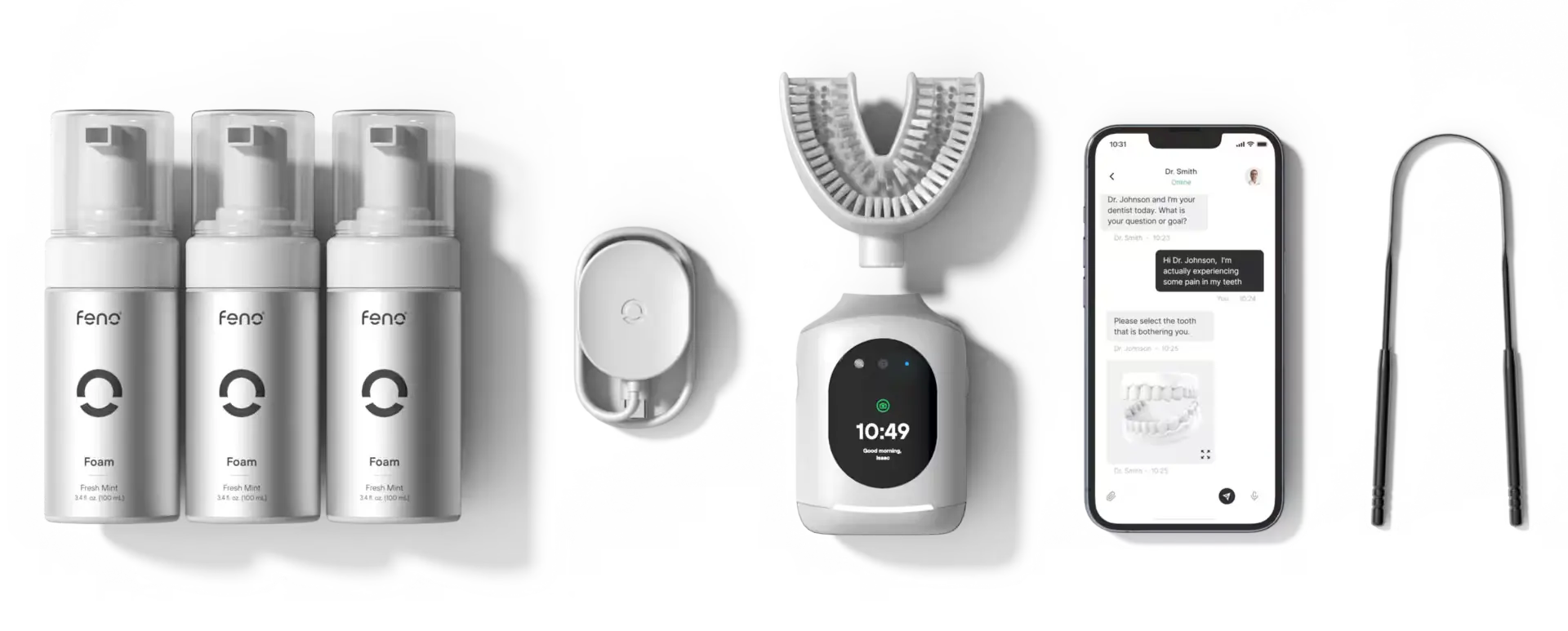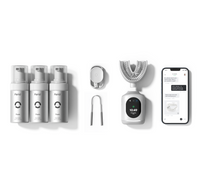
12 min read
Smart Oral Care: Reducing Disease Risks with Advanced Brushing
In the digital age, AI-powered dental care tools are transforming the landscape of oral hygiene. These innovations go beyond traditional brushing techniques by incorporating artificial intelligence to monitor and guide user behavior toward optimum dental health. The evolution of smart brushing habits has made it possible to achieve a level of cleanliness that was previously unattainable with manual brushes. This enhances everyday oral care and serves as a preventive measure against gum diseases and other related health issues.
Understanding Smart Toothbrush Technology
Smart Brushing for Plaque Removal
Traditional toothbrushes rely on the user's technique, which can be inconsistent and often ineffective at removing all plaque. In contrast, smart toothbrushes are designed with advanced sensors that precisely target plaque buildup, using just the right amount of pressure and timing. This ensures a thorough cleaning every time, crucial for preventing cavities and gum disease. The technology not only makes brushing more efficient but also educates users on how to maintain optimal oral hygiene.

The Role of Sensors
Sensors in smart toothbrushes play a crucial role in monitoring and improving brushing habits. These devices are equipped with various sensors that track each brushing session's frequency, duration, and coverage. The data collected is then analyzed to provide personalized feedback. For instance, if the sensors detect that brushing is too brief or misses certain areas consistently, the toothbrush can alert the user and suggest adjustments. Real-time feedback helps individuals develop better brushing habits, significantly enhancing their dental care regimen.
Tracking Oral Health
These devices can monitor changes in oral health over time and detect early signs of issues such as gum disease or cavities. By providing these insights, smart toothbrushes allow users to take proactive steps in consulting dental professionals before minor problems become severe. Also, the accumulated data can help dentists tailor treatments based on the individual’s specific needs, ensuring more effective and personalized care.
The Benefits of Smart Oral Care for Disease Prevention
How AI Improves Dental Hygiene
AI technology in smart toothbrushes assesses the user's unique brushing style and oral health status to offer customized feedback. This adaptation means that if the system notices soft tissue irritation or insufficient scrubbing in certain zones, it can adjust the user's brushing plan accordingly. A personalized approach helps prevent oral diseases by ensuring that all areas of the mouth are adequately cleaned, reducing the risk of periodontal disease and cavities through targeted advice and adjustments.
Smart Toothbrushes for Gum Disease Prevention
It also provides critical feedback on gum health, alerting users to areas with potential gum inflammation. By addressing these issues early, individuals can prevent the progression of gum disease, which is often silent until it becomes severe. The technology also focuses on gentle yet effective cleaning around the gum line, promoting healthier gums and reducing the likelihood of gum disease through consistent, proper brushing techniques.
Exploring Advanced Brushing Techniques
The Science Behind Ultrasonic Toothbrush Technology
Ultrasonic toothbrush technology utilizes high-frequency sound waves to break down plaque and bacteria beyond what traditional brushing can achieve. These sound waves generate a profound cleaning effect between teeth and below the gum line, providing a micro-massage that can improve gum health and disrupt plaque colonies. Advanced technology enhances cleanliness and increases the efficiency of each brushing session, promoting better oral health with less physical scrubbing effort required from the user.
Automatic Toothbrush Systems
These systems are designed to deliver consistent, optimal cleaning with minimal user effort. Such devices often feature a mouthpiece equipped with bristles that simultaneously clean all teeth surfaces. This comprehensive approach ensures even brushing across the entire mouth, crucial for preventing periodontal disease and achieving overall oral cleanliness. Automatic systems are particularly beneficial for individuals with limited dexterity or those who seek a more efficient, effective way to maintain their dental hygiene.
High-Tech Toothbrush Models
Smart electric toothbrush models offer a range of unique features designed to improve oral care:
- Multiple Brushing Modes: The innovation behind multiple brushing modes lies in its ability to adapt the brushing experience to a wide variety of oral health scenarios. Each mode is calibrated to deliver a unique motion, speed, and intensity combination that caters to different cleaning objectives. Users can switch modes depending on their daily requirements, such as choosing a whitening mode for aesthetic improvements or a gum care mode for soothing irritated tissues. This versatility is underpinned by sophisticated algorithms that monitor and adjust the real-time performance, ensuring that every stroke is optimized for efficacy and safety. The device’s design is informed by extensive research and clinical studies, which underscore the importance of varied brushing techniques to tackle diverse dental challenges. As a result, the multiple brushing modes enhance the overall cleaning process and empower users to take an active role in their oral health maintenance.
- Bluetooth Connectivity: One of the most notable features in contemporary toothbrush technology is Bluetooth connectivity, which bridges the gap between everyday dental care and the digital realm. This feature allows the toothbrush to communicate with smartphone applications, facilitating a seamless data transfer regarding brushing patterns, duration, and overall performance. By connecting to a mobile device, the toothbrush provides users with immediate feedback, offering suggestions and reminders that encourage a more thorough and consistent cleaning routine. The integration of Bluetooth technology creates an interactive ecosystem where dental care is continuously monitored and refined. Users can track their progress over time, accessing detailed insights into areas requiring additional attention. Furthermore, the data collected can be shared with dental professionals, fostering a collaborative approach to oral health management. This connectivity enhances accountability by motivating users to adhere to best practices by visualizing improvements and identifying potential issues early on. Beyond the practical aspects, Bluetooth-enabled toothbrushes represent a significant shift in how technology can personalize and enhance health-related routines.
- Timers and Quadrant Prompts: These smart devices employ timers that measure the overall brushing time and segment it into specific intervals, encouraging users to clean each section of their mouth evenly. The quadrant prompts serve as audible or visual cues that remind users to move to a different section of their mouth at designated intervals. This systematic approach to brushing ensures that no area is neglected, providing balanced cleaning coverage throughout the oral cavity. The internal timer is finely tuned to meet professional dental recommendations, typically advising at least two minutes of brushing, which is partitioned to focus on each quadrant. This thoughtful segmentation helps in reducing the risk of bacterial buildup in any specific region by promoting consistent movement and thorough cleaning. Also, these features work in tandem to foster better oral health habits by instilling a sense of discipline and regularity in the daily routine.
- Replaceable Brush Heads: The concept of replaceable brush heads in high-tech toothbrush models signifies a major advancement in dental care customization and maintenance. This feature allows users to periodically swap out the brush head, ensuring that the bristles remain in optimal condition for effective cleaning. Each brush head is engineered with unique bristle patterns and varying stiffness levels to address specific oral health challenges, such as plaque buildup, sensitive gums, or whitening needs. The design of these brush heads is rooted in extensive research, combining ergonomics and materials science to deliver an efficient and comfortable product. By offering a range of brush heads, manufacturers cater to users' diverse dental care needs, enabling a more personalized approach to oral hygiene. The replaceable nature of the brush head not only enhances performance but also contributes to the longevity of the device by ensuring that only the worn-out component is replaced rather than the entire unit.
With their innovative features and adaptive functionalities, they represent a significant leap forward in promoting better oral hygiene and encouraging proactive dental care.

The Role of AI and Automation in Dental Care Technology
AI-Powered Recommendations
The use of AI-powered recommendations in smart toothbrushes for health significantly refines the way we brush our teeth. This advanced AI evaluates brushing data over time to suggest optimizations tailored to the individual’s habits and needs. Personalized guidance ensures that every brushing session contributes to better oral health, making dental care more efficient and targeted.
How Digital Oral Care Solutions Adapt to Individual Needs
They consider factors like sensitivity and the presence of restorations, such as fillings or crowns, to customize the brushing experience. This adaptability ensures that users are not just cleaning their teeth but doing so in a way best suited to their specific oral health requirements. By accommodating individual differences, digital tools foster an inclusive approach to dental hygiene that is both comprehensive and personalized.
Integrating with Mobile Health Apps
It is important to consider how digital innovations are reshaping personal healthcare. These integrations revolutionize daily dental routines and empower users with data-driven insights, making oral care a proactive process. Below are the key features:
- Goal Setting and Monitoring: Once these goals are set, the app actively tracks progress, offering real-time updates highlighting accomplishments and identifying potential gaps in the routine. This feature transforms the act of brushing into a structured, measurable activity where every session contributes to a larger health narrative. Interactive dashboards display progress through intuitive graphs and metrics, making it simple for users to see incremental improvements over time. Notifications and gentle reminders reinforce consistency, ensuring that even on busy days, the importance of oral hygiene is not overlooked. Furthermore, these apps often allow customization based on user preferences, adapting to varying needs and lifestyle patterns. The feedback is tailored to encourage sustained effort without overwhelming the user, making goal setting a motivating process rather than a daunting task.
- Interactive Education: Users are exposed to customized guidance that addresses common pitfalls and emphasizes best practices for optimal dental care. The educational modules often include step-by-step demonstrations, visual aids, and even short video clips that break down complex techniques into manageable steps. This immersive learning approach ensures that users follow instructions and understand the underlying principles of effective oral hygiene. By receiving personalized education, users become more aware of how subtle adjustments in technique can lead to significant improvements in dental health. The apps update their content regularly to reflect the latest research and recommendations from dental professionals, ensuring that the information remains current and reliable. Interactive quizzes and progress checks further enhance the learning experience, enabling users to measure their understanding and retention of critical concepts.
- Professional Integration: These platforms enable users to seamlessly share detailed brushing data with their dental care providers, fostering a collaborative approach to oral health management. Through secure data transmission, dental professionals can access a patient’s brushing habits, identifying patterns that may signal potential issues or areas requiring targeted intervention. This digital dialogue lets dentists provide personalized advice based on concrete evidence rather than sporadic in-office observations. The integration complements routine check-ups, offering a continuous monitoring system that enhances preventive care. Patients benefit from timely interventions and tailored recommendations, which can lead to the early detection of dental problems, such as gum inflammation or plaque accumulation. Moreover, the professional integration feature can help streamline treatment plans, as practitioners can access historical data that informs decision-making and long-term care strategies. This collaborative ecosystem promotes a proactive relationship between patients and dental professionals, ensuring that care is both personalized and preventative.
- Reward Systems: Integrating reward systems into mobile health apps for smart toothbrushes for gum disease introduces an element of gamification that can significantly enhance user engagement and motivation. These systems transform routine dental care into an interactive challenge, where users earn rewards for consistent, proper brushing habits. The apps typically incorporate points, badges, or virtual incentives that celebrate milestones, such as completing a week of optimal brushing or achieving personal improvement targets. This gamified approach makes dental care fun and instills a sense of accomplishment, encouraging users to maintain their routines over the long term. The reward systems are particularly effective for younger users, turning brushing into an engaging activity rather than a mundane chore. The psychological impact of rewards for routine activities cannot be understated; it reinforces positive behavior and helps form lasting habits that contribute to oral health.
Each feature uniquely contributes to an ecosystem promoting thorough oral hygiene. This integration exemplifies how technology can empower individuals to take control of their health with intelligence and precision.
Factors to Consider Buying
Investing in smart dental technology requires consideration of several factors beyond just brushing features. Battery life, ease of use, availability of replacement heads, and compatibility with other smart devices are all essential to consider. Warranty and customer service offered by the manufacturer can play a crucial role in your decision, ensuring that your investment is protected and supported over time. Choosing the right toothbrush involves balancing these factors with your personal needs and preferences to find the best solution for maintaining dental health.

Smart oral care is indispensable for maintaining long-term dental health because it combines advanced technology with personalized dental hygiene practices. These devices do more than just clean; they provide critical feedback that helps users refine their brushing techniques, address potential issues early, and adapt their routines for optimal health outcomes. The continuous innovations in dental technology signify a shift towards more proactive and preventive oral care, which can significantly decrease the likelihood of developing serious dental diseases.
Share




